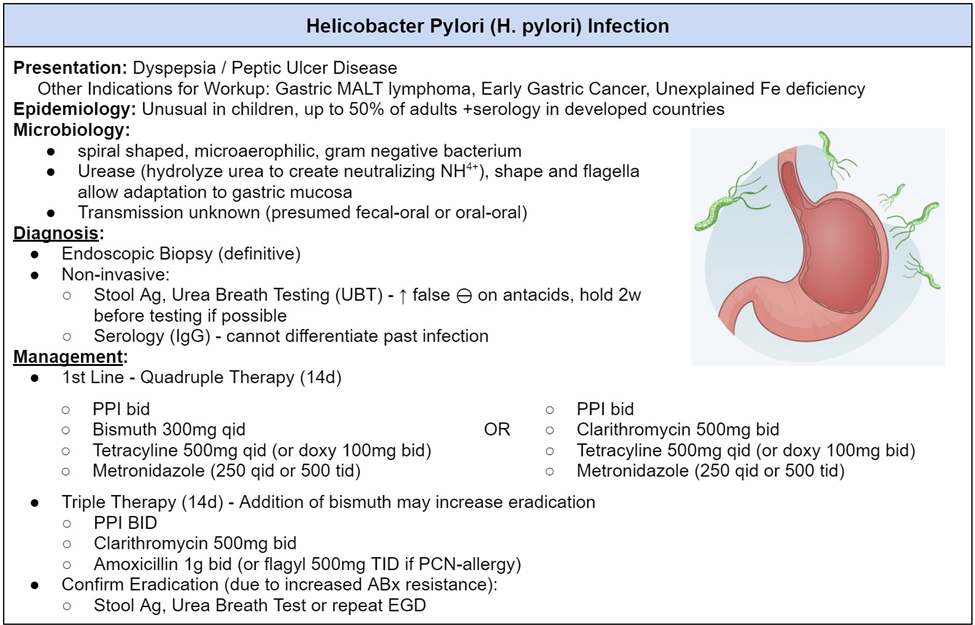A patient is suspected to have peptic ulcer disease from H. pylori. The patient asks the nurse what kind of testing will be done to determine the cause of the peptic ulcer. What will the nurse tell the client?
blood cultures will need to be drawn.
a biopsy of the stomach will be done.
a breath test will be performed.
computerized scanning will identify if H. pylori is present.
The Correct Answer is C
A. Blood cultures will need to be drawn.
Blood cultures are not typically used for diagnosing H. pylori infection. Instead, specific blood tests, such as serology or antibody tests, may be employed to detect antibodies against H. pylori.
B. A biopsy of the stomach will be done.
While a biopsy may be taken during an upper endoscopy to examine the stomach lining for ulcers and H. pylori infection, it is not the primary method for detecting the presence of H. pylori. The biopsy may be used for confirming the infection and assessing the severity of damage.
C. A breath test will be performed.
This is the correct choice. The breath test is a common and non-invasive method used to detect the presence of H. pylori. The patient drinks a solution containing a substance that H. pylori can break down, and the detection of carbon dioxide in the patient's breath indicates the presence of the bacteria.
D. Computerized scanning will identify if H. pylori is present.
Computerized scanning, such as computed tomography (CT) scans, is not a primary method for detecting H. pylori. Imaging studies are not typically used for H. pylori diagnosis, and the methods mentioned earlier, like breath tests and endoscopy, are more commonly employed.

Nursing Test Bank
Naxlex Comprehensive Predictor Exams
Related Questions
Correct Answer is A
Explanation
A. Avoid caffeine-containing beverages before sleep
The highest priority teaching point to help relieve sleeplessness would be to advise the client to avoid caffeine-containing beverages before sleep. Caffeine is a stimulant that can interfere with the ability to fall asleep and maintain a restful sleep.
B. Perform strenuous exercise before bedtime
Strenuous exercise close to bedtime can actually stimulate the body and make it more difficult for the individual to relax and fall asleep. It is generally recommended to engage in exercise earlier in the day.
C. Drink lots of fluids before bedtime
Drinking excessive fluids before bedtime may lead to disrupted sleep as it can increase the need to wake up for bathroom trips during the night. It's advisable to limit fluid intake close to bedtime.
D. Eat a heavy meal before bedtime
Consuming a heavy meal before bedtime can cause discomfort and indigestion, potentially disrupting sleep. It is recommended to have a light, easily digestible meal if eating close to bedtime.
Correct Answer is B
Explanation
A. Give the child fluids and proceed to the emergency department.
While giving the child fluids is generally important, proceeding to the emergency department without consulting poison control may not be the most appropriate initial action. Poison control can provide specific guidance based on the substance ingested.
B. Call the poison control center and follow directions.
The safest advice for a toddler who has ingested a small amount of household cleaning fluid is to call the poison control center and follow their directions. Poison control centers are staffed with professionals who can provide specific guidance based on the type and amount of the ingested substance. They can advise on the appropriate steps to take, such as whether immediate medical attention is needed or if monitoring at home is sufficient.
C. Administer syrup of ipecac and monitor for vomiting.
The use of syrup of ipecac is no longer recommended as a routine measure for ingested substances. It can have adverse effects and may not be effective for all substances. Consulting poison control for guidance is considered a more appropriate approach.
D. Have the toddler eat bread to absorb the substance.
The ingestion of certain substances may not be effectively addressed by having the toddler eat bread. The specific advice for management should come from poison control, which can provide evidence-based guidance.
Whether you are a student looking to ace your exams or a practicing nurse seeking to enhance your expertise , our nursing education contents will empower you with the confidence and competence to make a difference in the lives of patients and become a respected leader in the healthcare field.
Visit Naxlex, invest in your future and unlock endless possibilities with our unparalleled nursing education contents today
Report Wrong Answer on the Current Question
Do you disagree with the answer? If yes, what is your expected answer? Explain.
Kindly be descriptive with the issue you are facing.
